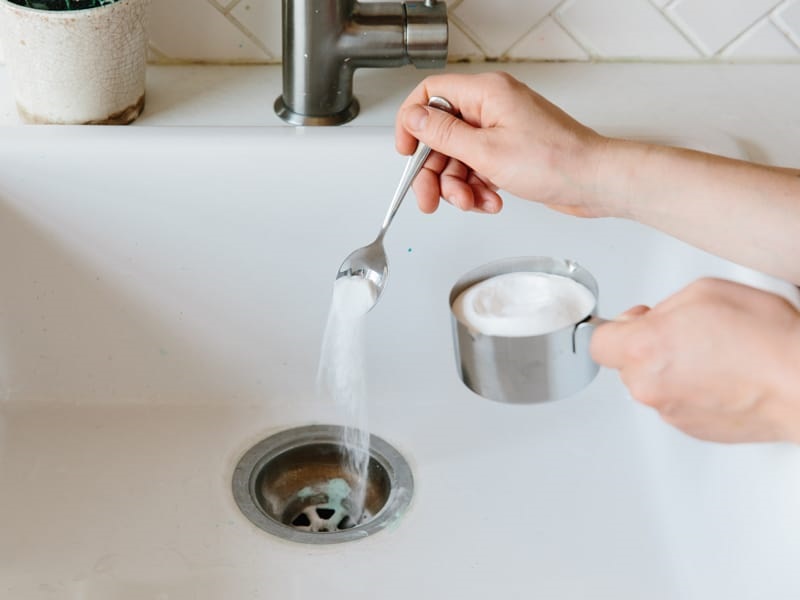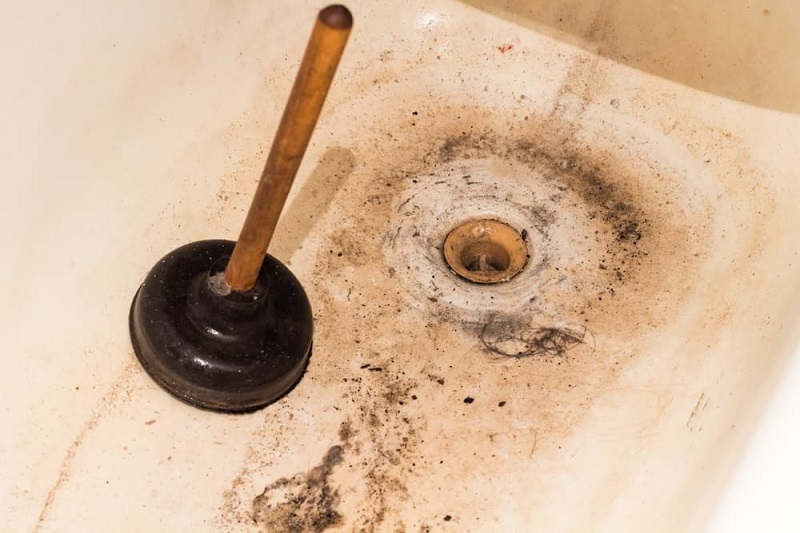Imagine stepping into your bathtub for a relaxing soak, only to be met with the frustration of standing water refusing to disappear. A clogged bathtub drain can quickly turn a peaceful moment into a plumbing predicament. While your initial instinct might be to reach for a plunger, there are actually several effective methods to tackle this common issue without one. In this guide, we’ll explore alternative approaches to unclogging your bathtub drain, giving you the know-how to restore the flow and reclaim your sanctuary of relaxation.
Understanding the Problem
Before diving into the solutions, let’s understand the problem at hand. A clogged bathtub drain can result from a variety of culprits, ranging from hair and soap scum to foreign objects accidentally finding their way down the drain. However, tackling a clog becomes particularly challenging when the water is standing rather than draining normally. In such cases, traditional plunging might not provide the desired results. But fear not, because we’ve got a toolkit of effective methods to help you out.
The Anatomy of a Clogged Bathtub Drain
The first step in tackling any clog is understanding what’s causing it. Hair, soap residue, and small debris are often the main offenders in bathtub drain blockages. Over time, these substances accumulate, creating a stubborn barrier that water struggles to penetrate. Additionally, mineral buildup can contribute to the problem, exacerbating the blockage and making it difficult for water to flow freely.
The Challenge of Standing Water
Dealing with standing water adds an extra layer of complexity to the unclogging process. Plunging might not be as effective in these scenarios, as the standing water often prevents a proper seal between the plunger and the drain. This is where alternative methods come into play, offering innovative ways to break down and remove the clog without relying on traditional tools.
Preparation for Unclogging
Before you embark on your unclogging journey, ensure you have the necessary supplies on hand. You’ll need items like rubber gloves, a bucket, a flashlight, and the chosen unclogging method’s ingredients or tools. Having everything ready ensures a smoother process and minimizes the risk of any mishaps.
Dress for Success: Protecting Yourself from Mess
Unclogging a drain can get messy, so it’s wise to don a pair of rubber gloves and wear clothes you don’t mind getting a bit dirty. This will protect your hands and clothing from any debris or substances you might encounter during the unclogging process.
Clear the Area: Make Room for Work
To give yourself ample space to work, clear the area around the bathtub. Remove any toiletries, bath mats, or other items that might hinder your movements. This will help you navigate around the tub comfortably as you work to remove the clog.
Method 1: Baking Soda and Vinegar
The Dynamic Duo: How Baking Soda and Vinegar Work
Baking soda and vinegar are two household ingredients that, when combined, create a fizzing reaction. This reaction can help break down the substances causing the clog and clear the drain. It’s a natural and eco-friendly approach that’s worth a try.
Step-by-Step: Executing the Baking Soda and Vinegar Method
- Start by removing any visible debris from the drain.
- Pour a pot of hot water down the drain to help loosen the clog.
- Pour half a cup of baking soda directly into the drain.
- Follow the baking soda with half a cup of vinegar. Quickly cover the drain with a cloth or plug to contain the fizzing action.
- Let the mixture sit for about 15 minutes to allow the chemical reaction to work its magic.
- Flush the drain with another pot of hot water to help wash away the loosened debris.
The Science Behind the Fizz: Breaking Down the Clog
The fizzing action created by the baking soda and vinegar combination helps break down the buildup inside the drain. Baking soda is mildly abrasive, and the fizzing action helps dislodge debris, while the vinegar’s acidity helps dissolve mineral deposits. This method is particularly effective for minor clogs and is easy to execute with ingredients found in most households.
Method 2: Boiling Water
The Power of Heat: How Boiling Water Can Help
Boiling water is a simple yet powerful tool for unclogging drains. The heat from the water can melt away grease and other substances that might be contributing to the clog. This method is especially useful for hair-based clogs and those caused by soap scum.
Caution: Using Boiling Water Safely
When using boiling water, exercise caution to avoid burns. Slowly pour the boiling water down the drain in two to three stages, allowing it to work its way through the clog. This gradual approach minimizes the risk of splashing and ensures the water has time to melt the blockage.
Unleash the Heat: Pouring Boiling Water to Remove the Clog
- Boil a pot of water and let it cool slightly for a minute or two.
- Slowly pour the boiling water down the drain in stages, pausing for a few seconds between each pour.
- Listen for any sounds of the clog breaking up, and observe whether the water starts to drain more freely.
Method 3: Wire Hanger Hook
A Simple Tool: Crafting a Hook from a Wire Hanger
A wire hanger can be repurposed into a simple yet effective tool for removing clogs. By bending the hanger into a hook shape, you can use it to reach into the drain and pull out hair and debris.
Delicate Precision: Navigating the Drain with the Hook
- Straighten a wire hanger and bend one end into a hook shape.
- Insert the hooked end into the drain and gently maneuver it to catch onto hair and debris.
- Slowly pull out the captured debris, being careful not to push it further down the drain.
Fishing Out the Gunk: Slowly Removing the Blockage
Using a wire hanger hook requires patience and precision. The goal is to hook onto the clog and gently pull it out. This method is especially effective for hair-based clogs that are close to the drain’s surface.
Method 4: Wet and Dry Vacuum
Vacuuming the Clog: How the Wet and Dry Vacuum Works
A wet and dry vacuum can be a powerful ally in unclogging a drain. It creates a strong suction that can dislodge and remove the clog. This method is particularly useful for clogs that are resistant to other methods.
Seal the Deal: Creating an Airtight Seal for Maximum Suction
- Set your wet and dry vacuum to the wet setting.
- Cover the vent of the vacuum with a cloth to create an airtight seal.
- Place the vacuum nozzle directly over the drain, ensuring a tight fit.
Clearing the Path: Watching the Clog Disappear
Turn on the vacuum and let it run for a few minutes. The powerful suction created by the vacuum can draw out the clog and any debris that’s causing the blockage. This method is effective for stubborn clogs and provides a mechanical solution to the problem.
Method 5: Salt and Baking Soda Mixture
The Abrasive Solution: Combining Salt and Baking Soda
Salt and baking soda can be combined to create an abrasive mixture that helps break down stubborn clogs. This method works well for mineral buildup and tougher blockages.
Breaking Down the Sludge: The Chemical Reaction
- Mix equal parts salt and baking soda in a bowl.
- Pour the mixture down the drain, ensuring it’s distributed evenly.
- Let the mixture sit for several hours or overnight to allow it to penetrate the clog.
Flushing It Away: Letting Water Do the Job
After the mixture has had time to work, flush the drain with hot water. The abrasive action of the salt and baking soda, combined with the power of water, can help dislodge and flush away the clog.
Method 6: Plumbing Snake
A Professional Tool: Introducing the Plumbing Snake
A plumbing snake, also known as a drain auger, is a flexible tool designed to navigate through pipes and break up clogs. While it might seem more advanced, it’s a highly effective method for deep and stubborn clogs.
Step-by-Step: Inserting and Maneuvering the Snake
- Insert the plumbing snake into the drain slowly and carefully.
- Rotate the snake’s handle to navigate through the pipes, gently pushing through the clog.
- Continue maneuvering the snake until you feel the resistance lessen.
Feeling the Victory: When the Snake Breaks Through
When you sense the plumbing snake has broken through the clog, slowly retract it from the drain. This method is particularly useful for clogs that are deeper within the pipes and challenging to access with other methods.
Method 7: Dish Soap and Hot Water
Everyday Heroes: How Dish Soap and Hot Water Help
Dish soap and hot water might be sitting in your kitchen, but they can also come to the rescue in unclogging your bathtub drain. This method works by breaking down grease and soap scum, allowing the clog to dislodge.
Mixing It Up: Creating the Perfect Solution
- Squirt a generous amount of dish soap down the drain.
- Boil a pot of water and let it cool slightly.
- Pour the hot water down the drain, following the dish soap.
Pour and Wait: Allowing the Solution to Work its Magic
After pouring the mixture down the drain, give it some time to work. The dish soap will help break down the grease and grime, while the hot water will flush it away. This method is gentle on pipes and effective for organic-based clogs.
Method 8: Enzyme Cleaners
Natural Allies: The Power of Enzyme Cleaners
Enzyme cleaners are eco-friendly solutions designed to break down organic matter, making them an excellent choice for clogs caused by hair and soap scum. They work gradually but effectively over time.
Let It Sit: Giving Enzymes Time to Break Down the Clog
- Follow the instructions on the enzyme cleaner’s packaging for the appropriate dosage.
- Pour the enzyme cleaner down the drain.
- Let it sit for several hours or as recommended on the packaging.
Eco-Friendly Option: The Benefits of Enzyme Cleaners
Enzyme cleaners are a more natural and eco-friendly option compared to harsh chemical drain cleaners. They work by using biological processes to break down the clog, making them safe for both your pipes and the environment.
Prevention and Maintenance
Keeping It Flowing: Regular Maintenance Tips
To prevent future clogs, consider implementing these maintenance tips:
- Use drain covers to catch hair and debris.
- Flush drains with hot water regularly to prevent buildup.
- Avoid pouring grease and oil down the drain.
Mind the Drain: What Not to Let Go Down the Drain
Certain items should never be allowed down the drain:
- Grease and oil
- Coffee grounds
- Food scraps
- Cotton swabs
Healthy Habits: Preventing Future Clogs
By adopting healthy drain habits and being mindful of what goes down the drain, you can minimize the risk of clogs in the future. Prevention is key to maintaining the smooth flow of water in your bathtub.
When to Call a Professional
Knowing Your Limits: Signs You Need Professional Help
While these methods can be effective for minor clogs, there are instances when it’s best to call a professional plumber:
- Persistent and stubborn clogs
- Clogs that recur frequently
- Foul odors emanating from the drain
Finding a Plumber: Choosing the Right Expert for the Job
If your attempts to unclog the drain have been unsuccessful, it’s time to enlist the help of a professional plumber. Research and choose a reputable plumber who has experience in tackling various types of drain issues.
Saving the Day: When Professionals Take Over
Professional plumbers have the expertise and specialized tools to handle even the most stubborn clogs. They can diagnose the issue accurately and provide a long-lasting solution to restore proper drainage in your bathtub.
Conclusion
In the world of home maintenance, unclogging a bathtub drain might seem like a daunting task, but armed with the right knowledge and methods, you can take control of the situation. Whether you’re using baking soda and vinegar, a plumbing snake, or one of the other methods we’ve explored, each approach offers a unique way to tackle clogs and restore the tranquility of your bathing experience.
FAQs
- Can I use chemical drain cleaners for unclogging?
Chemical drain cleaners can be harsh on your pipes and the environment. It’s best to opt for more natural methods like those discussed in this article.
- How often should I perform maintenance to prevent clogs?
Regular maintenance, such as flushing drains with hot water and using drain covers, should be done every few weeks to prevent buildup and potential clogs.
- What if none of the methods work?
If your attempts are unsuccessful, it’s advisable to call a professional plumber. Persistent clogs might require specialized equipment to clear.
- Are enzyme cleaners safe for septic systems?
Yes, enzyme cleaners are generally safe for septic systems as they contain natural ingredients that break down organic matter without harming the system.
- Can I use a wet and dry vacuum for other clogs around the house?
Yes, a wet and dry vacuum can be versatile for various clogs, such as in sinks and toilets. Just be sure to adjust settings and use proper attachments for different scenarios.




